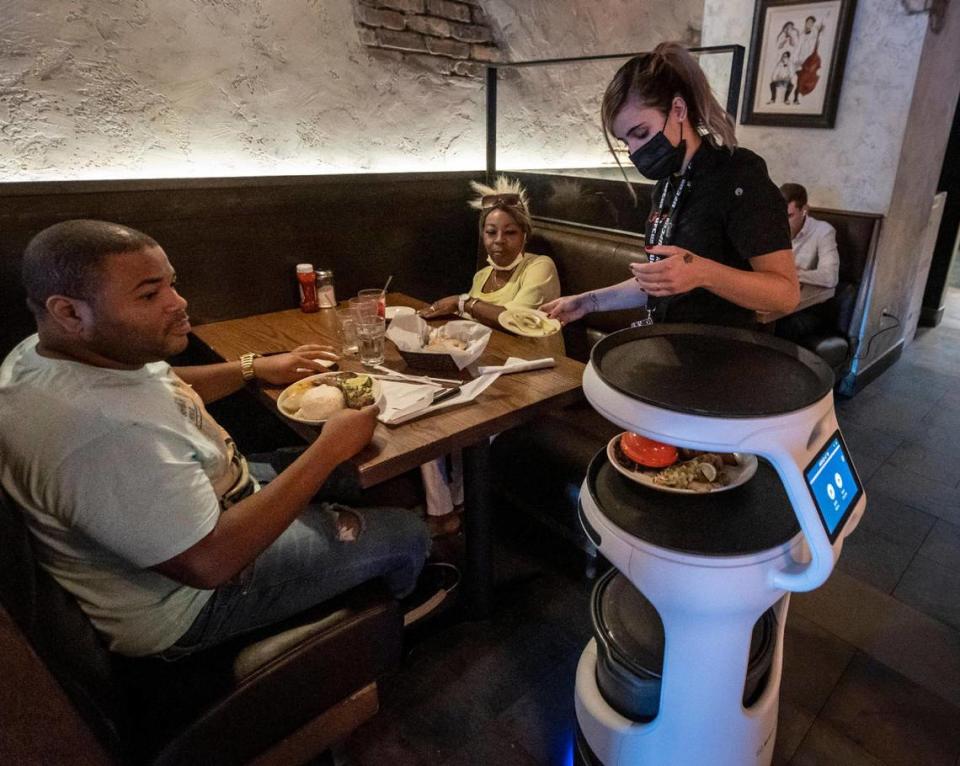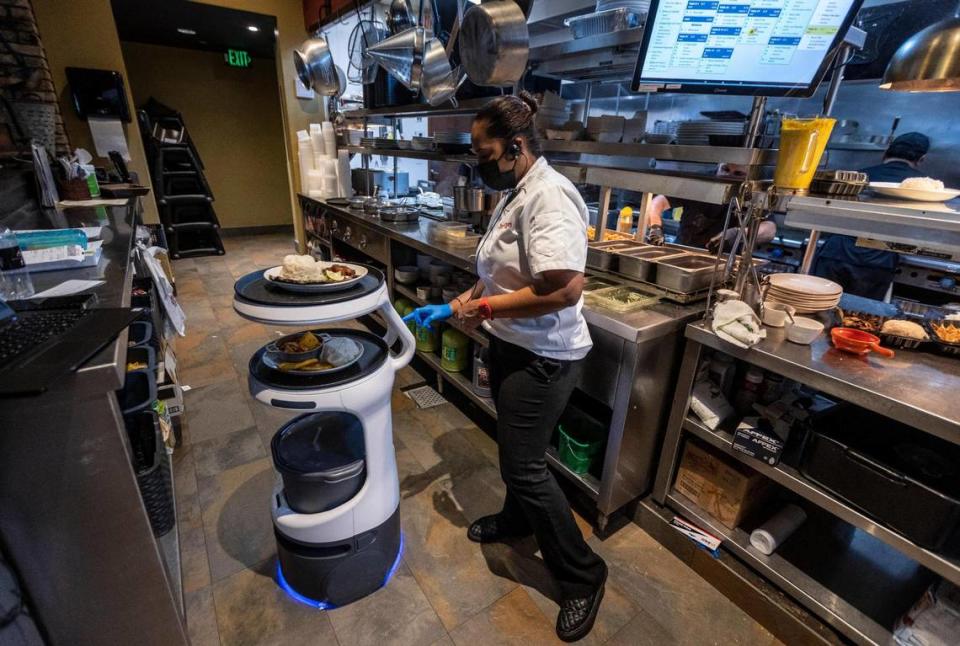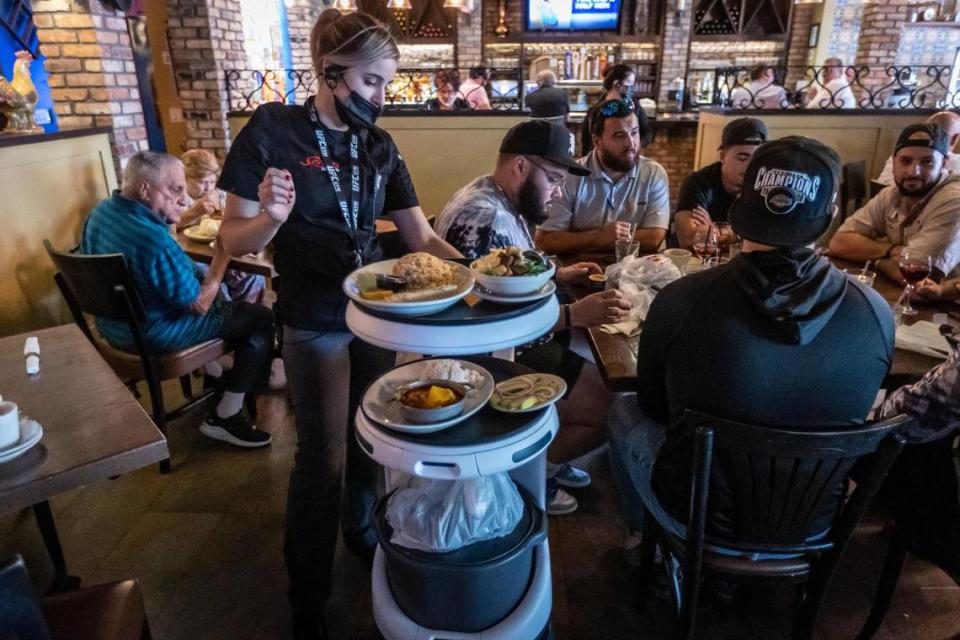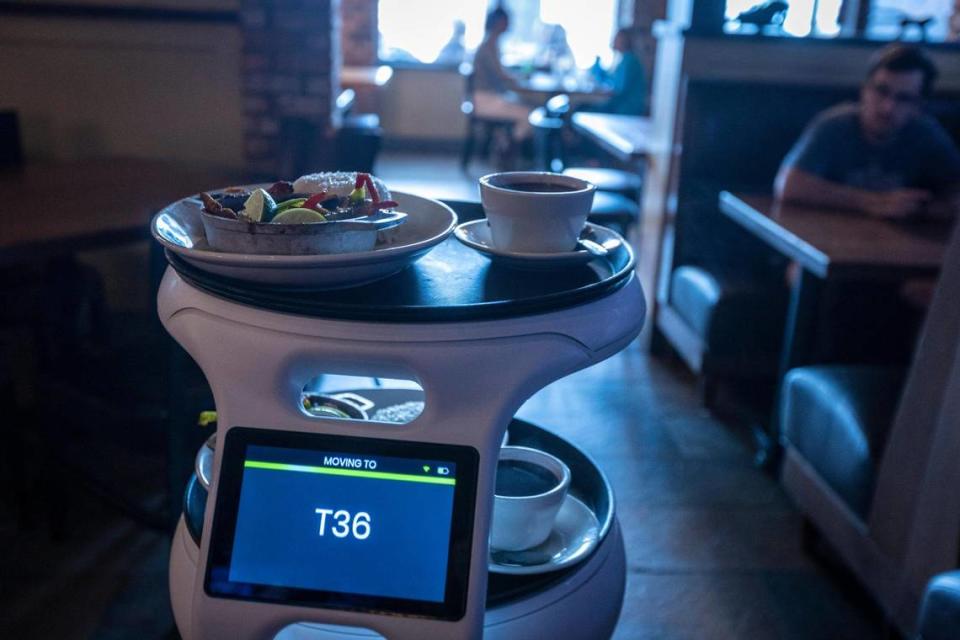Your favorite Miami restaurant has a new waiter — but he’s not human. Is the future here?
Here you are at a restaurant again. It’s packed and you’re hungry for a good Cuban meal. Where is the waiter?
After helping another table, the server heads your way with several plates of food. He doesn’t want to bump into other customers, so he waits, then says “excuse me” and “thank you.”
But he can’t hand you the food. He carries it in his belly. And he’s not even human.
Your waiter is a robot, and the future is right here at Sergio’s in West Kendall.
Robot at work
It’s a scene right out of the Jetsons, minus the flying cars. You watch other customers pull out their phones and snap a video.
“They are astonished,” Customer Service Manager Lorena Tomatis says, laughing.
Meet ASTRO — that’s short for Automated Service Tray Removal Organizer. He’s hard at work at the Sergio’s at 8807 SW 107th Ave. The robot is a little shorter than your average human waiter, three feet tall and a foot wide, but he pulls his weight carrying plates and using sensors to get around.

He can even speak Japanese, Korean and English. But despite his employment at a popular Cuban restaurant, he’s still working on his Spanish. And he will eventually learn how to sing “Happy Birthday” like all those live waiters, said Sergio’s CEO Carlos Gazitua.
Like other Florida businesses rising from COVID restrictions, Sergio’s is hiring. But not enough people are applying. The company needs 8 to 15 employees at each restaurant to fill vacancies, Gazitua said. So the restaurant reviewed how it could improve the workplace for employees who have been “heroes in our community,” he said.
Staff ‘burnout’
What the company learned is that some employees felt “burnout” from the extra workload that comes with a short-staffed restaurant. Some felt like they were always running to and from the kitchen. Longtime servers said their back and wrist ached from carrying plates.
So Sergio’s executives contacted Bear Robotics, a Silicon Valley company that specializes in automated robots for the restaurant and hospitality industry. Juan Higueros, chief operating officer and co-founder, is from Miami.
How the robot helps
As part of a month-long trial period, they introduced ASTRO to help carry trays of food and return dirty dishes to the kitchen. Humans still serve the food to seated customers.
Sergio’s pays ASTRO a $2-$3 hourly salary. The robot doesn’t take tips.
But the lone robot won’t be alone for long. Gazitua said the Sergio’s chain just signed a deal with the technology company to hire Servi robots at other Sergio’s locations in South Florida. The goal, Gazitua said, is to relieve Sergio’s human workers of some of the work that takes them away from helping customers in other, more human ways.
“As crazy as it sounds, I think the robot is going to give us more opportunity to be human because the robot is going to give us more time that we can have a personal connection with the guests,” he said.

Already, servers at the Kendall location are excited to let the robot take on some of their work.
For Tomatis, taking breaks or sitting down is a lot easier now that the robot does some of the table-clearing. There’s more time to circle back to customers, and that means more tips. With only three servers gliding around the restaurant on a busy afternoon, she’s tired but she has more energy than a few days ago.
“From the kitchen until the table you have an extra 30 seconds, which when you’re waitressing — it’s a lot. You can go do something else, drinks — whatever — and go to another table,” Tomatis said.
It’s not the first food-serving robot in the Miami area. A food firm is using a robot to deliver dinner from a network of remote kitchens making food for people who live in downtown Miami.
Sergio’s Manager Claudia Rodriguez says servers can walk miles around the restaurant’s floor on a busy day, so the little robot is a relief. The staff, she said, is thrilled because they can handle more tables at once.
“Trust me, you walk so much. You walk miles and miles,” Rodriguez said. “They’re really happy about it.”
The customers

On Tuesday, Elvis Calderon munched on egg whites and chicken breast after ASTRO brought food to the table.
“He’s a nice help,” Calderon said. “We don’t have that human help right now in the restaurants.”
So what did the designers think of when designing ASTRO? Simple: Helping the human worker.
Higueros, of Bear Robotics, said the question in his mind was: “What are the things I can offload to a robot that I don’t necessarily need to do?”
The answer to that, he said, is for the robot to pick up the “grunt work.”
That means duties like rushing to transport food and returning dirty dishes. Managing several tables at once and carrying heavy plates made customer service difficult to maintain for the humans on staff.
“You come to the restaurant for your food and the service, and that got lost in the shuffle there somehow,” he said. “The human interaction is never going to be replaced — that’s what you want. You want your servers to spend time with your customers.”
Why are we seeing this automated technology? Could it replace workers?

The use of automated technology has increased in the food service industry in the past 15 months, said Geoff Luebkemann, the senior vice president of the Florida Restaurant & Lodging Association. Gazitua, Sergio’s CEO, is part of the association’s executive committee.
The technology has been used in the industry for years, usually in the kitchen to make food preparation easier and faster. But then came the pandemic.
Dining rooms shuttered and converted to takeout and contact-less delivery. Some restaurants pivoted to makeshift grocery stores, selling produce, meat and toilet paper. Many workers lost their jobs.
Now, as more people are vaccinated and life slowly returns to normal, restaurants are struggling to hire help. That created the “perfect storm” for automated technology to expand in the industry, Luebkemann said.
He expects the industry will continue to adapt new technologies to improve the customer experience, just like how many restaurants now give people the option to pay for their food at the table using a tablet instead of waiting for a worker to bring the check.
But the changes that happen, he said, will largely rely on what customers are demanding.
“The public will tell us what they want.”
Sergio’s CEO says he even wants to make the robot more human.
Gazitua said he’d love to get local artists, including famous ones like Willy Chirino, to record audio that can be put in the robot to create personalized Happy Birthday wishes for their customers.
When people go to a full-service restaurant, they’re going for an experience involving “great food, great service, great hospitality,” he said. And “the secret sauce is the people.”

